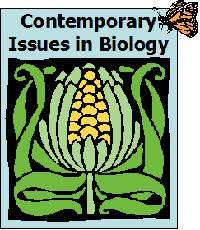
Week 10, Chapter 7 -- Digging Deeper Sample Answer
Course home | Weekly schedule | Announcements | Instructor Info | Desire2Learn | MasteringBiology® | Honor Code | FAQs | HELP!
 |
Week 10, Chapter 7 -- Digging Deeper Sample AnswerCourse home | Weekly schedule | Announcements | Instructor Info | Desire2Learn | MasteringBiology® | Honor Code | FAQs | HELP! |
Chosen trait and environmental influences: I chose to study the growth rate of toenails because I have observed that not everyone’s toenails grow equally fast. I have to clip mine every few weeks, whereas other people I know seem to be clipping theirs all the time. Although I imagine this trait is at least partially under genetic control, there are probably some environmental influences on the rate of toenail growth as well. For example, many people’s toenails are infected by fungi that might accelerate or depress the growth rate. Wearing tight shoes might depress the growth rate too, and diet might also have an effect.
Experimental approach: To determine the heritability of the rate of toenail growth, I would use a correlation study. This seems like the best choice for this situation because (a) it is not practical or ethical to use human subjects in artificial selection experiments and (b) it’s difficult to find enough twins for twin studies, and let’s face it, the rate of toenail growth isn’t important enough to make it worthwhile to locate identical twins separated at birth. Correlation studies are simpler because it’s easy to find families with parents and children.
Experimental design and measurement technique: I would recruit at least 200 sets of volunteers – parents and their biological children – to measure the rate of toenail growth over six months. How would I measure growth rate? Before the six-month experimental period started, I would have everyone measure the distance between the tip of the left big toenail and the cuticle at the base of the nail. If each subject measures this distance at the start of the six-month period, and again before each time the nails are clipped, then we can determine each person’s total linear growth over six months.
Predictions: If the rate of toenail growth has high heritability, the parents with the highest toenail growth rates should have children with the highest growth rates (and likewise for parents with low growth rates). If the growth rate has low heritability, I would expect that parent growth rates would not be correlated with child growth rates at all.
Limitations: Correlation studies are tricky because they assume that similarities between children and their parents are inherited. In fact, children and their parents usually share the same environment. That is, they probably have the same sort of diet, live in the same climate (temperature and humidity), and live in the same physical location. If we consider the environmental influences I mentioned earlier, the toenail fungus could lurk in the bathrooms that the whole family shares, infecting everyone. Likewise, diet is also likely to be similar for the whole family. Shoe tightness is a different story – I guess it depends on who buys the shoes and how fast the kids grow out of them!
[475 words]
[Back to Digging Deeper assignment]
[Sample assignment by Mariëlle Hoefnagels]